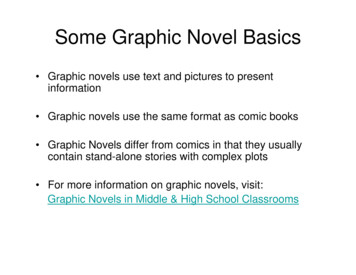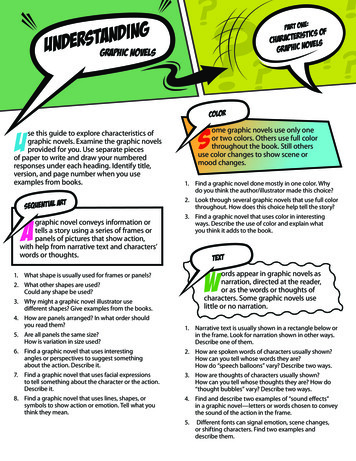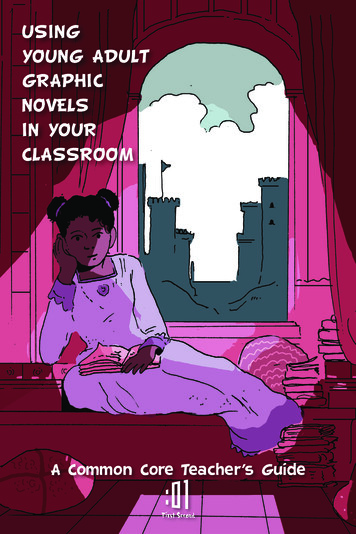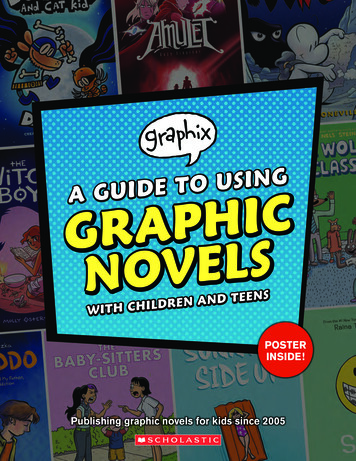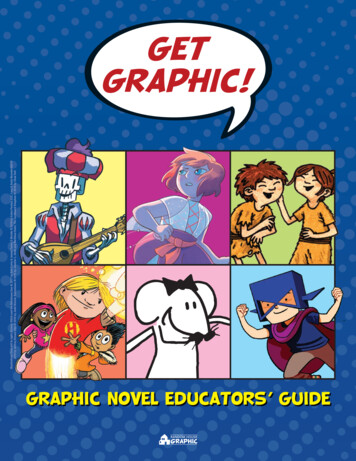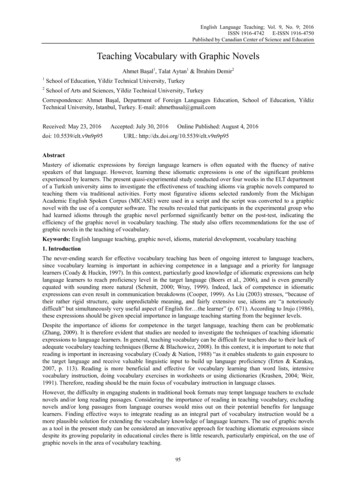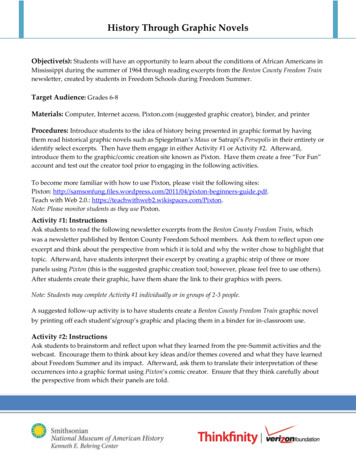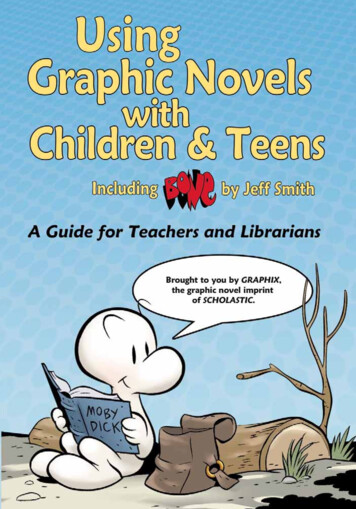
Transcription
Using Graphic Novels in the ClassroomA Guide for Teachers and LibrariansGraphic novels are hot! No longer an underground movement appealing to a smallfollowing of enthusiasts, graphic novels have emerged as a growing segment of bookpublishing, and have become accepted by librarians and educators as mainstreamliterature for children and young adults—literature that powerfully motivates kids to read.At Scholastic we’re leading the way with our new Graphix imprint launched in spring2005.Are graphic novels for you? Should you be taking a more serious look at this format?How might graphic novels fit into your curriculum and your classroom? What are somespecific ideas for how to do this, using Scholastic’s new editions of Bone by Jeff Smith?Want to know more? If so, this guide—co-written by a school librarian and a publiclibrarian who are both well-known experts in the field—is for you!Section 1: An Overview of Graphic NovelsWhat are graphic novels?Are graphic novels suitable for the young?Best Web sites about graphic novelsBest books about graphic novels for youth librarians and teacherspagepagepagepageSection 2: Answering Your Questions about Graphic NovelsDo graphic novels promote literacy?Are graphic novels “real books”?The place of graphic novels in the curriculumpage 4page 5page 5Section 3: Introduction to Bone by Jeff SmithWhat is Bone?The story behind the publishing of BoneWhy teach Bone? Comparing its themes to classical mythologyStudying graphic novels as a formatpage 5page 6pages 6–7pages 8–9Section 4: Hands-on Classroom Activities Using BoneDiscussion questions for Bone #1: Out from BonevilleDiscussion questions for Bone #2: The Great Cow RaceCreative writing activities using Bonepage 10page 10page 11Section 5: More about This Teaching GuideWhat the critics have said about BoneAbout the two experts who wrote this teaching guideHow to order Bonepage 12page 12page 13Section 6: What Other Books Are Being Published inScholastic Graphix and Other Scholastic Imprints?Upcoming publications23334pages 14–18
1An Overview of Graphic NovelsWhat are graphic novels?“Graphic novel” is a term used by librarians, educators, and booksellers to indicate a publishingrmat—books written and illustrated in the style of a comic book. The term “graphic novel”as first popularized by Will Eisner to distinguish his book A Contract with Godd (1978)from collections of newspaper comic strips. He described graphic novels as consistingof “sequential art”—a series of illustrations which, when viewed in order, tell a story.Although today’s graphic novels are a recent phenomenon, this basic way of storytellinghas been used in various forms for centuries—early cave drawings, hieroglyphics, andmedieval tapestries like the famous Bayeux Tapestry can be thought of as stories told inpictures. The term graphic novel is now generally used to describe any book in a comicformat that resembles a novel in length and narrative development. Award-winning, criticallyacclaimed graphic novels such as Bone, Persepolis, Maus, and The Tale of One Bad Rat are primeexamples of this new type of contemporary literature.Are graphic novels suitable for theyoung, and how do I evaluate them?Some parents, educators, and librarians may associate the term “graphic novel” with contentthat includes violence, adult language, and sexually provocative images. Although there aremany comics and graphic novels that contain these elements, there is also a growing bodyof graphic novels that are free of such content and are suitable for all ages, including children. Reviews of graphic novels appear regularly in School Library Journal, Booklist, Voiceof Youth Advocates, Library Media Connection, Publishers Weekly, and other journals. Byreading these reviews; seeking the advice of trusted retailers, wholesalers, and publishers; andby previewing materials prior to circulation, you should be able to build a collection that issuited to your audience. It is the goal of the Scholastic Graphix imprint to increase the rangeand variety of graphic novels published for children.Whatt areforree the best WebWeb sitessifoforfinding outt aboutgraphicnovels?abooutt gragrraphic novnoveo els?ovls?Comic Books for Young Adults: A Guide for /lml/comics/pages/index.htmlNo Flying, No Tights: A Web site Reviewing Graphic Novels for Teenswww.noflyingnotights.comRecommended Graphic Novels for Public Librarieshttp://my.voyager.net/ sraiteri/graphicnovels.htm3
What are some of the best books about graphicnovels for youth librarians and teachers?The Public Librarian’s Guide to Graphic Novels,published by Book Wholesalers, Inc.The 101 Best Graphic Novels,by Steve Weiner, published by NBM.Getting Graphic! Using Graphic Novels to Promote Literacy withPreteens and Teens, by Michele Gorman, published by Linworth Publishing.Graphic Novels 101: Selecting and Using Graphic Novels to PromoteLiteracy for Children and Young Adults—A Resource Guide for SchoolLibrarians and Educators, by Philip Crawford, published by Hi Willow Publishing.Graphic Novels in Your Media Center: A Definitive Guide,by Allyson A.W. Lyga and Barry Lyga, published by Libraries Unlimited.2Answering Your Questions about Graphic NovelsDo graphic novels promote literacy?Graphic novels powerfully attract kids and motivate them to read. Many public librarians have built up graphic novel collections and have seen circulation figures soar.School librarians and educators have reported outstanding success getting kids toread with graphic novels, citing particularly their popularity with reluctant readers,especially boys—a group traditionally difficult to reach. At the same time, graphicnovels with rich, complex plots and narrative structures can also be satisfying toadvanced readers.Graphic novels can also help improve reading development for students struggling with languageacquisition, as the illustrations provide contextual clues to the meaning of the written narrative. Whengraphic novels are made available to young people, even those deemed “poor readers” willingly andenthusiastically gravitate toward these books. Providing young people with diverse reading materials,including graphic novels, can help them become lifelong readers.4
AreArere graphicgrraphic novelsgranovo els “realov“rereeal books”?booksbookss”?Some parents and educators may feel that graphic novels are not the type of reading material thatwill help young people grow as readers—they may dismiss graphic novels as inferior literatureor as “not real books.” However, quality graphic novels have increasingly come to be accepted bylibrarians and educators as a method of storytelling on a par with novels, picture books, movies, oraudiobooks. The excellent graphic novels that are available today are linguistically appropriatereading material demanding many of the same skills that are needed to understandtional works of prose fiction. They require readers to be actively engaged inprocess of decoding and comprehending a range of literary devices, includingrrative structure, metaphor and symbolism, point of view, the use of punsd alliteration, intertextuality, and inference. Reading graphic novels can helpdents develop the critical skills necessary to read more challenging works,uding the classics.Do graphic novels have aplace in the curriculum?Many educators have reported great success when they have integrated graphicnovels into their curriculum, especially in the areas of English, science, socialstudies, and art. Teachers are discovering that graphic novels—just like traditional formsof literature—can be useful tools for helping students critically examine aspects of historscience, literature, and art.3Introduction to Bone by Jeff SmithWhat is Bone?Bone—an award-winning, critically acclaimed graphic novel series that has been describedas Pogo meets The Lord of the Rings—tells about the adventures of three cousins: FoneBone (good, kind, brave, and loving), Smiley Bone (the Harpo Marx–type funny guy), andPhoney Bone (greedy and scheming). In the first of the nine volumes, Out from Boneville,the three cousins are lost in a vast uncharted desert after having been banished from theirhome of Boneville. Fone Bone finds his way into a deep, forested valley filled with wonderfuland terrifying creatures. Eventually, he’s reunited with his two cousins at a farmstead runby tough Gran’ma Ben and her spirited granddaughter Thorn. But little do the Bones know,there are dark forces conspiring against them, and their adventures are only just beginning.5
What is the story behind the publishing of Bone?The author/artist of Bone, Jeff Smith, runs a company called Cartoon Books and lives inColumbus, Ohio, with his wife and business partner, Vijaya Iyer. After starting his career drawingcomic strips for newspapers and starting his own animation studio, Jeff Smith started selfpublishing Bone in 1991. He says it’s the book he always longed to read when he was nine — a giantcomic book saga that had all the plot and character-journey elements of a long, satisfying novel likeMoby Dick or The Odyssey. Bone has won many awards and has been published in sixteen languages.In 2004, Scholastic acquired the rights to publish Bone in Graphix, Scholastic’s new graphic novelimprint. Previously illustrated in black-and-white, Bone is now being reissued by Scholastic in fullcolor, in nine volumes released at six-month intervals, published simultaneously in hardcoverand paperback.Whyhyhy teach Bone?Bone?s a wonderfully entertaining, humorous work of highthat can also be studied and discussed as an epicure with many parallels to mythology. Teaching thesents of literature through the medium of a graphic novel,cussing the parallels between Bone and other epics,s The Iliadd and The Odyssey, will provide teachers withortunity to introduce something different into theulum. Using graphic novels alongside traditional worksterature can elicit renewed interest in these topics,and motivate those students who may have had littleinterest in reading and studying literature.uding Bone in the English/Language Arts curriculumovide teachers with a tool for helping students identifynts of classical mythology, the heroic quest, and culturalnces.6
For example:The journey homeThe three Bone cousins do not deliberately set out to have an adventure. Like Odysseus leaving Troy inThe Odyssey, all they really want to do is return home. Their entire adventure is actually a long detouron the road home.The unlikely heroLike Bilbo Baggins in The Lord of the Rings, or Harry Potter in the Harry Potter books, Fone Bonestarts out as just an ordinary person with no pretensions of being a hero. When he is thrust intoextraordinary circumstances, his qualities of humility, goodness, and courage eventually make him ahero despite himself.The hero’s questThe heroic journey—or quest—that the Bone cousins embark on is symbolic of the search for self.Compare their quest to that of Dorothy in The Wizard of Oz or Bilbo Baggins in The Lord of the Rings.Joseph Campbell’s seminal book, The Hero with a Thousand Faces, talks about the five steps of a heroicquest. How are the experiences of the Bone cousins similar or different?The unknown destinyLike King Oedipus in Oedipus Rex, or Aragorn in The Lord of the Rings, or heroes in other timelessfairy tales, young Thorn is in a long line of heroines and heroes who are raised either unaware of thedestiny they are born into, or far from the kingdom they will someday rule.The mentor wizard figureMerlin from the Arthurian legends, Gandalf from The Lord of the Rings, and Dumbledore from Harry Potterrepresent classic wizard figures. Students can compare and contrast them with Great Red Dragon, thementor wizard figure in Bone — a cigar-smoking dragon who is only visible to a select few.Allusions to American literature and filmFone Bone’s love of the American classic Moby Dick signals readers that Jeff Smith’s cartoon epic is,in a way, a tribute to this epic novel. The experiences of the Bone cousins are reminiscent of Ishmael’sjourney — when they return home, they bring no worldly goods, only a better understanding ofthemselves and the world they live in.When Fone Bone asks Great Red Dragon why he scared some rat creatures away rather than breathingfire on them, he answers, “Never play an ace when a two will do,” a nod to the laconic tough-guyHumphrey Bogart movie persona.7
Whyhy study graphicaphic novelsnovo els as a format?ovfoformar at?rmatt?Students can learn much bystudying how graphic novels “work,” and comparing them toother forms of storytelling. Novels speak to us usually in a linearwritten narrative; picture books tell a story with text accompanied byllustrations; film does so with moving images and dialogue; and poetryan communicate on levels that no other storytelling can.Graphic novels combine all these elements in their own unique way.hey are like prose in that they are in a written printed format, butthey are also like film in that they tell a story through visual imagesthat, although static, give the impression of movement, accompaniedby the characters’ dialogue. The sequential pictures in a graphic novel contain dialogue yet also tellimportant aspects of the story visually. Readers derive information from facial and bodily expressions,and the composition and viewpoint of the illustrations; and—as in a movie—they can sometimes deducewhat happened—but was not explicitly stated—in the interval between one image and the next.Everyone has had the experience of being so engrossed in a riveting novel that they feel as if they’rewatching a movie of the story in their imagination. Graphic novels heighten that experience—theyare literature that is actually in a cinematic format, so that as you read it you experience “in real time”everything that happens in it. Finally, graphic novels might also be compared to some works of poetry inthe way they can convey intangible feelings through allusion rather than direct description.8
Conveying emotion and personalityIn Bone, Smith conveys a range of emotions and explores diverse personality types withdrawings that appear simple but that convey a great deal of information. For example, there’s the angryfrustration of Phoney Bone when the cousins are arguing over the map early in Out from Boneville, conveyed not only by his argumentative dialogue but also by his scrunched eyebrows, impatient gestures, andthe beads of sweat flying off of him. Other examples are the dreamy expression on Fone Bone’s face whenhe first meets Thorn, his expression of pride when he shows Moby Dick to Thorn, and the happy face Smiley Bone makes as he and Phoney Bone find each other near the end of Out from Boneville. In each case,students can analyze how the emotion is conveyed both through the words and the pictures.Information conveyed through the pictures without wordsNear the end of Out from Boneville, Fone Bone is so overcome with feelings of love for Thorn that hefalls backward off the cow he is riding, and the reader sees hearts floating up from him. This image ishumorous in a slapstick way, yet also very touching. Is part of its effectiveness the way in which it isconveyed without words? If Bone were a conventional novel, the author would have to convey the samefeelings through written narrative. How would this be different for the reader?Information conveyed through point of viewIn every illustration, the artist chose a particular viewpoint from which to observe the action. Howdoes Jeff Smith make use of this choice? How does he convey information, or a mood, through thecomposition of each picture? At the very end of Out from Boneville, we observe the Bone cousins beinghappily reunited—from the viewpoint of a hidden, hooded figure looking down on them from the trees.From this we learn that the Bone cousins are being followed—that they are going to be threatened withdanger—and that they are unaware of this. The book thus ends on an exciting cliffhanger that makes youwant to read more. Comparethis to cinematic techniquesin many well-known movies.Invite students to find otherexamples where theviewpoint of the pictureis critical to the reader’sexperience of the story.9
4Hands-on Classroom Activities Using BoneWhat are some discussion questionsfor Bone #1: Out from Boneville?1. Have you ever been far from home without knowing how you would get back?What did it feel like?How did you deal with the situation?2. When we first meet the Bone cousins, they are running from Boneville. Buknow why they are leaving.How do we find out?Do we get the whole story?3. The Bone cousins are very devoted to each other.What is loyalty?Would you leave your town with your cousins if you had to?Under what circumstances?Is there a limit to loyalty?4. Who is your favorite Bone cousin? Why?5. How are the cousins alike? How are they different?What are some discussion questionsfor Bone #2: The Great Cow Race?1. What are Rat Creatures?What are they afraid of?2. Why does Lucius wager that Gran’ma Ben will win the cow race?3. Smiley Bone acts like he’s stupid, but things always seem to go his way.Why?4. Thorn thinks she remembers living with dragons. At the end of The Great Cow Race, Gran’maBen tells Lucius that the dragon is back.Is Thorn remembering something that really happened, or something that she dreamed?5. Fone Bone is afraid to tell Thorn how much he likes her, so he expresses his feelings in a poem.Are there advantages to expressing your feelings on paper rather than face to face?Have you ever done that?Was it successful?6. Gran’ma Ben tells Lucius that Thorn is “a good judge of character.”What does that mean?10
WhatareWree someome creativecre writingwriwritr tingingactivitiesactctivitiesctivities using Bone?BoneBone?1. A critical moment in Out from Boneville is when Fone Bone first meets Thorn. Have students write the storyin their own words from that point forward.What do they think will happen?If Fone Bone hadn’t met Thorn, how would Fone Bone’s experience have been different?2. Have students write the story from the moment Fone Bone discovers the mystery cow scamin The Great Cow Race.If Fone Bone had exposed his cousins, how would the story have been different? Have them write thestory the way they think it would have been with that outcome.3. Have students make up a story about life in Boneville before the cousins were chased out, using the informationprovided in Out from Boneville and The Great Cow Race, and perhaps adding their own inferences.4. Some writers describe every detail of an incident, including everything the characters are thinking andfeeling. Others provide a bare outline of what happened and let the reader make inferences and “fill in theblanks.” Discuss the pros and cons of these approaches.What impact does each approach have? Take the moment when Fone Bone is so overcome with love forThorn that he falls backward off his cow, referred to on page nine—an incident that Jeff Smith conveyswithout a single word. Have students narrate this incident in words, using prose or poetry in a variety ofstyles, to convey the same feelings that Jeff Smith depicts visually.11
5More about This Teaching GuideWhat have the critics said about Bone?ttiest writing(“Some of the witliterature in recenof any children’sexcit:litkidssclastfirmemory.This isgh thatand resonant enouing, funny, scary,e.”timglonaders forit will stick with rea— Publishers Weekly, starred review“Both cute and scary.While children will read Bonefor its breathless adventure.older kidsand adults will appreciate the themes ofblind fanaticism and corrupting power.”— Time Magazine“Bone moves frombrash humor togrippingadventure in asingle panel.”“A true accomplishment.asuperb example of storytelling.”— Booklist— School Library Journallectedonks were seAssociatiBone booan LibrarycriemrAcks foby ther Paperbaas Popula002)(2sltuYoung Ad“An instantly likable andintermittently hilarious adventurefor children with a subtler, grimmer storyabout power and corruption at its core.”— The Washington PostWho wrotewrororotote thisthis teaching guide?guidguguideu e?This guide combines the contributions of two authors who are each highly regarded experts in the field ofgraphic novels for youth librarians and teachers.Philip Crawford, Library Director for Essex Junction High School in Vermont, contributed primarily tothe sections on graphic novels.He has been a high school English teacher and was a curriculum specialist for the San FranciscoUnified School District. He has conducted workshops at numerous conferences, including the AmericanAssociation of School Librarians, the Vermont Library Association, and the California School LibraryAssociation. His column “A Juvenile Miscellany” is published regularly in Knowledge Quest, and hisbook reviews have appeared in School Library Journall and Library Media Connection. He is the authorof Graphic Novels 101: Selecting and Using Graphic Novels to Promote Literacy for Children andYoung Adults—A Resource Guide for School Librarians and Educators.Stephen Weiner, Director of the Maynard Public Library in Maynard, Massachusetts, contributed primarilyto the sections on Bone.He has written about comic art since 1992 and is an expert on Bone. He writes the “Graphic NovelRoundup” column in School Library Journal, and has published articles and reviews in Voice of YouthAdvocates, Library Journal, The Shy Librarian, English Journal, and other journals. His books includeBring an Author to Your Library (1993), 100 Graphic Novels for Public Libraries (1996), The 101 BestGraphic Novels (2001), and Faster than a Speeding Bullet: The Rise of the Graphic Novell (2003), andhe is co-author (with N.C. Christopher Couch) of The Will Eisner Companion (2004).12
How can I order Bone?The following volumes of Bone by Jeff Smith are available from Scholastic:Bone #1: Out from BonevilleBone #2: The Great Cow RaceBone #3: Eyes of the StormHC: 0-439-70623-8 978-0-439-70623-0 19.99/ 24.99 CAN.PB: 0-439-70640-8 978-0-439-70640-7 9.99/ 12.99 CAN.HC: 0-439-70624-6 978-0-439-70624-7 19.99/ 24.99 CAN.PB: 0-439-70639-4 978-0-439-70639-1 9.99/ 12.99 CAN.HC: 0-439-70625-4 978-0-439-70625-4 18.99/ 25.99 CAN.PB: 0-439-70638-6 978-0-439-70638-4 9.99/ 12.99 CAN.Bone #4: The DragonslayerBone #5: Rock JawHC: 0-439-70626-2 978-0-439-70626-1 19.99/ 24.99 CAN.PB: 0-439-70637-8 978-0-439-70637-7 9.99/ 12.99 CAN.HC: 0-439-70627-0 978-0-439-70627-8 19.99/ 24.99 CAN.PB: 0-439-70636-X 978-0-439-70636-0 9.99/ 11.99 CAN.Bone #8: Treasure Hunters(August 2008)HC: 0-439-70630-0 978-0-439-70630-8 19.99/ 24.99 CAN.PB: 0-439-70633-5 978-0-439-70633-9 9.99/ 11.99 CAN.Bone #6: Old Man’s CaveHC: 0-439-70628-9 978-0-439-70628-5 19.99/ 24.99 CAN.PB: 0-439-70635-1 978-0-439-70635-3 9.99/ 11.99 CAN.Bone #7: Ghost Circles(February 2008)HC: 0-439-70629-7 978-0-439-70629-2 19.99/ 24.99 CAN.PB: 0-439-70634-3 978-0-439-70634-3 9.99/ 11.99 CAN.Watch for Bone volume 9,Crown of Horns, published in February 2009.For more information about the Bone books published by Scholastic,visit www.scholastic.com/bone13
6What Other Books Are Being Published inScholastic Graphix and Other Scholastic Imprints?na ClugstonA funny, yet stinging, look at the social hive of middle-school girls,where only one “queen bee” can rule!“Bubbly, fun, and smart .Everything works in thisfunny, charming, and true story.” ——Publishers Weekly“Highly recommended.” —Kliatt—Chynna Clugston, an Eisner Award nominee, is the creator of the popularBlue Monday and Scooter Girl comic series. She has also worked on Buffythe Vampire Slayer comics and Marvel Comics collections.Queen Bee #1HC: 0-439-71572-5 978-0-439-71572-0 16.99/ 21.99 CAN.PB: 0-439-70987-3 978-0-439-70987-3 8.99/ 11.99 CAN.by Ann M. Martinadapted and illustrated byRaina TelgemeierBased on Ann M. Martin’s bestselling series, America’s favorite baby-sitters areback! Raina Telgemeier captures all the drama of the original books in warm,spunky, and hilarious graphic novels. Brought to life in this vivid new format,the four baby-sitting friends will captivate a whole new generation of readers.“Plenty of content, comedy, action, and emotion.” —Booklist—“A spirited graphic novel adaptation.” ——Publishers WeeklyThe Baby-sitters Club #1: Kristy’s Great IdeaHC: 0-439-80241-5 978-0-439-80241-3 16.99/ 21.99 CAN.PB: 0-439-73933-0 978-0-439-73933-7 8.99/ 11.99 CAN.The Baby-sitters Club #2: The Truth About StaceyHC: 0-439-86724-X 978-0-439-86724-5 16.99/ 20.99 CAN.PB: 0-439-73936-5 978-0-439-739336-8 8.99/ 10.99 CAN.The Baby-sitters Club #3: Mary Anne Saves the DayPB: 0-439-88516-7 978-0-439-88516-4 8.99/ 10.99 CAN.The Baby-sitters Club #4: Claudia and Mean Janine (November, 2008)PB: 0-439-88517-5 978-0-439-88517-1 8.99/ 10.99 CAN.Watch for further Baby-sitters Club adventures.14
adapted from the booksby R. L. StineCreepy creatures are howling, growling, and stalking through these coolnew anthologies, each containing three Goosebumps stories individuallyadapted into comic format by different artists.Creepy CreaturesIllustrated by Scott Morse, Greg Ruth, and Gabriel HernandezHC: 0-439-84124-0 987-0-439-84124-5 16.99/ 21.99 CAN.PB: 0-439-84125-9 987-0-439-84125-2 8.99/ 11.99 CAN.Terror TripsIllustrated by Jill Thompson, Jamie Tolagson, and Amy Kim GanterHC: 0-439-85777-5 987-0-439-85777-2 16.99/ 20.99 CAN.PB: 0-439-85780-5 987-0-439-85780-2 8.99/ 10.99 CAN.Scary SummerIllustrated by Ted Naifeh, Dean Haspeil, and Kyle BakerPB: 0-439-85782-1 987-0-439-85782-6 8.99/ 10.99 CAN.Breaking Up:A Fashion High Graphic NovelAimee FriedmanIllustrated by Christine NorriePB: 0-439-74867-4 978-0-439-74867-4 8.99/ 10.99 CAN.Sexy, stylish chick lit — in a graphic novel! High school Chloe findsher close friendship with her three best friends imperiled when shefalls for a guy who’s definitely not part of the in-crowd.“Expect heavy circulation.” —Booklist—“I recommend this graphic novel highly.” —Kliatt—15
COMING SOON FROM GRAPHIX!Written and Illustrated byKazu KibuishiThere’s something strange down in the basement.After a family tragedy, Emily, Navin, and their mother move to anold ancestral home to start a new life. On the family’s very firstnight in the mysterious house, Em and Navin’s mom is kidnappedby a humongous, tentacled creature and dragged down behindthe basement door. The kids give chase—and find themselves in amagical but dangerous world of man-eating demons, a mechanicalAmulet Book 1: The StonekeeperKazu Kibuishirabbit, a giant robot, and shadowy enemies.Watch for Amulet: Book 2(January 2008)HC: 0-439-84680-3 978-0-439-84680-6 21.99/ 26.99 CAN.PB: 0-439-84681-1 978-0-439-84681-3 9.99/ 11.99 CAN.Magic Pickle(Illustrated Chapter Books)Written and Illustrated by Scott Morse(March 2008)A dilly of a superhero to the rescue!Meet the Magic Pickle, a flying kosher dill secret weapon, created in a secretgovernment lab under the floor of little Jo Jo Wigman’s bedroom. He’s here tosave the world from The Brotherhood of Evil Produce who are threatening totake over the world—or at least kill us with fruit and vegetable puns!Magic Pickle Vs. the Egg PoacherPB: 0-439-87997-3 978-0-439-87997-2 5.99/ 7.99 CAN.Magic Pickle and the Planet of the GrapesPB: 0-439-87996-5 978-0-439-87996-5 5.99/ 7.99 CAN.Watch for the Magic Pickle graphic novel, published in summer 2008.16
The Knights of the Lunch TableFrank Cammuso(Summer 2008)A new series from Eisner-Award nominee Frank Cammuso!The Arthurian legend is hilariously reborn when Artie King, a nice, comicsloving kid, enters Camelot Middle School and instantly makes both friendsand foeThe Dodge Ball ChroniclesPB: 0-439-90322-X 978-0-439-90322-6 9.99/ 11.99 CAN.Watch for Knights of the Lunch Table #2, published in summer 2009Walker BeanAaron Renier(Fall 2008)In a rollicking tale, a young boy stowaway has to thwarta band of pirates and break an evil curse to save hisgrandfather’s life.PB: 0-439-87422-X 978-0-439-87422-9 9.99/ 11.99 CAN.Watch for Walker Bean #2, published in fall 2009The Good NeighborsHolly Black(Fall 2008)From the author of the bestselling Spiderwick Chronicles and Tithe comes a fantastical new series abouta girl who discovers she is part of the faerie realm—and must engage with it for the first time after herfather is framed for her mother’s death.PB: 0-439-85565-9 978-0-439-85565-5 9.99/ 11.99 CAN.Watch for The Good Neighbors #2.Salem HydeFrank Cammuso(Spring 2009)Salem Hyde isn’t your average third-grade girl. For one thing, she has magical powers; for another, she’sa genius. She knows a few spells, but she can’t spell very well. Sometimes all these qualities mix well.Sometimes they don’t—that’s when the mischievous misadventures begin!PB: 0-439-90318-1 978-0-439-90318-9 Price to comeWatch for Salem Hyde #2, coming in spring 2010.17
Star Diaries: The Seventh VoyageAdapted and Illustrated by Jon J Muth,based on a short story by Stanislav Lem(Fall 2009)When a boy’s space ship flies through a strange vortex that bends time and space in odd ways, he begins tomeet up with versions of himself from the past weeks, months, and years.PB: 0-545-00463-2 978-0-545-00463-3 9.99/ 11.99 CAN.The Woodland ChroniclesGreg Ruth(Fall 2009)Fifty years ago a boy named Walt disappeared. Strange woodland creatures seem to be responsible.Can twelve-year-old Nathan Superb solve the mystery and save the world from a cataclysmic battle?PB: 0-439-82332-3 978-0-439-82332-6 9.99/ 11.99 CAN.PUBLISHED BY ARTHUR A. LEVINE BOOKSThe ArrivalBy Shaun Tan(October 2007)Transcendent artwork captures the struggles and joy of the immigrant experience.In a heartbreaking parting, a man gives his wife and daughter a lastkiss and boards a steamship. He’s embarking on the most difficultjourney—he’s leaving home to build a better future for his family.In this wordless graphic novel, Shaun Tan capt
many comics and graphic novels that contain these elements, there is also a growing body of graphic novels that are free of such content and are suitable for all ages, including chil-dren. Reviews of graphic novels appear regularly in School Library Journal, Booklist, Voice

